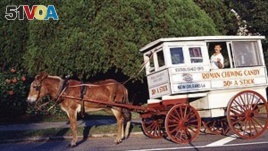July 16, 2012
The colorful old southern seaport of New Orleans, Louisiana, is full of character - and characters: mimes and clowns on Jackson Square, “Lucky Dog” men who sell hot dogs from carts shaped like wieners in a bun, boys who’ll shine your shoes and tap-dance in the street for a dollar or two.
And eccentrics of all sorts, some in scandalous costumes or barely any costume at all, each year during Carnival season.

Ron Kotteman, and Rosie, on the job. You can tell this photograph was taken a few years ago, just by looking at the posted price for the “candy man's” wares. (Carol M. Highsmith)
One New Orleans character who’s still going strong after nearly a century is the “Roman Candy Man,” with his Roman Chewing Candy wagon pulled by a mule named Patsy.
Here’s his story.
Back in 1915, when Ron Kottemann’s grandfather, Sam Cortese, was a young man, he used to sell fruit and vegetables and a little bit of homemade Italian taffy, or soft “pull candy,” that Cortese’s mother made back in her kitchen.
He sold all this from a white wagon pulled by a mule, and he’d ring a gong to let everyone know he was passing through.
Pretty soon, the candy was selling better than the produce, so he repainted the wagon, called it the “Roman Chewing Candy Wagon,” and went back to rolling about town. Just one cart and one mule.
Cortese’s mother had other things to do than make taffy, so Sam figured out a way to make candy on the move, inside the wagon, using a very hot stove and a vat to cool the taffy in.

An artist captured two New Orleans institutions in one: the venerable St. Charles Avenue streetcar, and the Roman Candy Man. Even the peddler's mule has become a bit of an icon. (www.thepastwhispers.com)
He’d boil taffy in three flavors - chocolate, vanilla, and strawberry. After a big wad of it had cooled, he’d scoop it up with a stick and throw it onto a big hook, hanging in the window of his wagon. Then he’d tug on the taffy, pull out a long string of it, snip it off with scissors, wrap it waxed paper, and sell it to people who lined up on the street.
Back then, a long strand of Roman taffy cost a nickel - five cents.
Almost a century later, Ron Kottemann does exactly the same thing that his grandfather did. He’s been at it for 40 years, and he has 40 years’ worth of stories. They include one about the time a car hit his wagon and knocked it over, spilling red-hot taffy all over him. His mule, Rosie, came through it OK.
These days, the taffy costs a dollar a strip - 20 times as much as it did in Sam Cortese’s day - and the candy is now also made in a little factory in town that ships it to taffy-lovers around the world.
But on the streets of Old New Orleans, there’s still just one Roman Chewing Candy wagon, one taffy peddler, and one mule, named Patsy.